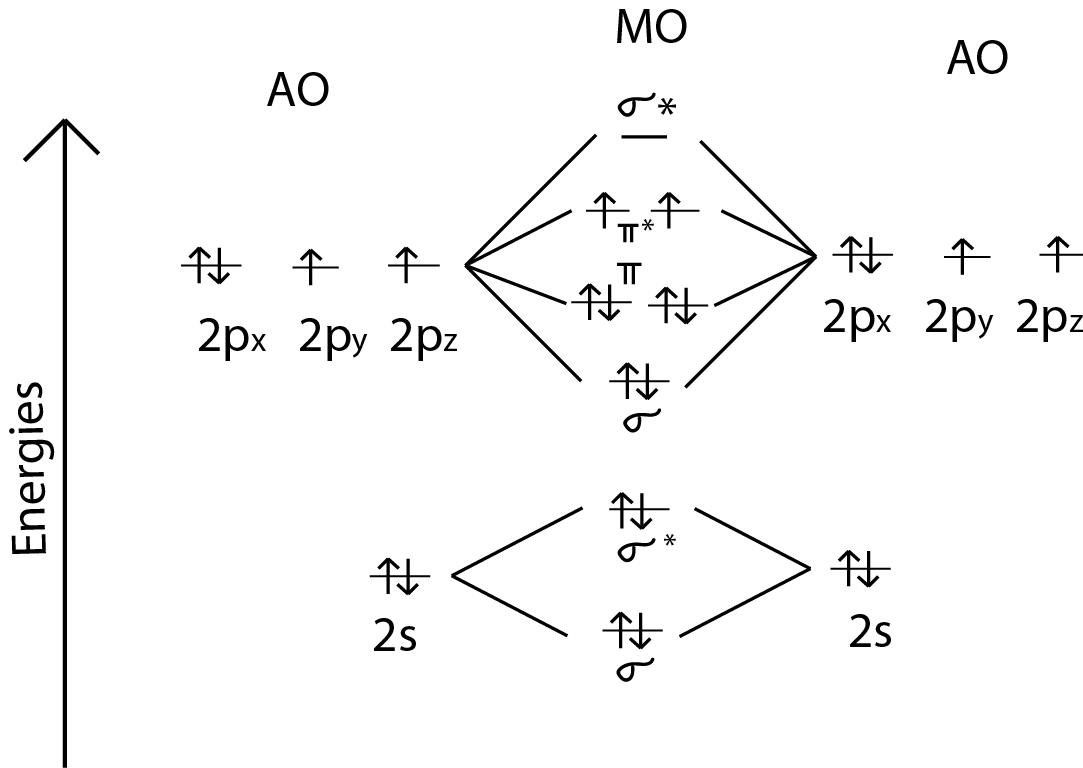
What is LUMO of $ {{{O}}_{{2}}} $ molecule?
(A) $ {{2p}}\sigma $
(B) $ {{2p}}\pi $
(C) $ {{2p}}\sigma * $
(D) $ {{2p}}\pi {{*}} $
Answer
429.9k+ views
Hint: The location of an electron in a molecule is described by a mathematical function which is known as molecular orbital. The highest occupied molecular orbital is known as HOMO and the lowest unoccupied molecular orbital is known as LUMO.
Complete step by step answer:
Molecular orbital: The mathematical function used to describe the location and the waveform of an electron in a molecule is known as molecular orbital.
In chemistry two types of molecular orbital are defined HOMO and LUMO. The full form of HOMO is the highest occupied molecular orbital and the full form of LUMO is the lowest unoccupied molecular orbital.
The diagram used to represent the distribution of electrons is as follows:

From the above diagram we can see that the electronic configuration for the oxygen is as follows:
$ {{\sigma }}_{{{1s}}}^{{2}}{{\sigma }}_{{{1s}}}^{{{*2}}}{{\sigma }}_{{{2s}}}^{{2}}{{\sigma }}_{{{2s}}}^{{{*2}}}{{\sigma }}_{{{2p}}}^{{2}}{{\pi }}_{{{2}}{{{p}}_{{y}}}}^{{2}}{{\pi }}_{{{2}}{{{p}}_{{y}}}}^{{{*2}}}{{\pi }}_{{{2}}{{{p}}_{{x}}}}^{{1}}{{\pi }}_{{{2}}{{{p}}_{{y}}}}^{{{*1}}}{{\sigma }}_{{{2p}}}^{*0} $
So as we can see that last empty orbital is $ {{\sigma }}_{{{2p}}}^* $ and it is the lowest unoccupied molecular orbital, so the LUMO for $ {{{O}}_{{2}}} $ molecule is $ {{2p}}\sigma * $ .
Hence option (C) is correct.
Additional information:
The bond order for the molecular orbitals is also determined by the electronic configuration, bond order decides the stability of a molecule. The half of the difference of the bonding and antibonding electrons is considered as the bond order. The bond order for the oxygen molecule is 2 (two). The unpaired electrons in the electronic configuration of $ {{{O}}_{{2}}} $ describes that the oxygen molecule is paramagnetic in nature.
Note:
Molecular orbital theory describes the existence of molecules on the basis of bond order. But this concept of bond order fails in some cases like in the case of polyatomic molecules, it is only suitable for diatomic molecules.
Complete step by step answer:
Molecular orbital: The mathematical function used to describe the location and the waveform of an electron in a molecule is known as molecular orbital.
In chemistry two types of molecular orbital are defined HOMO and LUMO. The full form of HOMO is the highest occupied molecular orbital and the full form of LUMO is the lowest unoccupied molecular orbital.
The diagram used to represent the distribution of electrons is as follows:

From the above diagram we can see that the electronic configuration for the oxygen is as follows:
$ {{\sigma }}_{{{1s}}}^{{2}}{{\sigma }}_{{{1s}}}^{{{*2}}}{{\sigma }}_{{{2s}}}^{{2}}{{\sigma }}_{{{2s}}}^{{{*2}}}{{\sigma }}_{{{2p}}}^{{2}}{{\pi }}_{{{2}}{{{p}}_{{y}}}}^{{2}}{{\pi }}_{{{2}}{{{p}}_{{y}}}}^{{{*2}}}{{\pi }}_{{{2}}{{{p}}_{{x}}}}^{{1}}{{\pi }}_{{{2}}{{{p}}_{{y}}}}^{{{*1}}}{{\sigma }}_{{{2p}}}^{*0} $
So as we can see that last empty orbital is $ {{\sigma }}_{{{2p}}}^* $ and it is the lowest unoccupied molecular orbital, so the LUMO for $ {{{O}}_{{2}}} $ molecule is $ {{2p}}\sigma * $ .
Hence option (C) is correct.
Additional information:
The bond order for the molecular orbitals is also determined by the electronic configuration, bond order decides the stability of a molecule. The half of the difference of the bonding and antibonding electrons is considered as the bond order. The bond order for the oxygen molecule is 2 (two). The unpaired electrons in the electronic configuration of $ {{{O}}_{{2}}} $ describes that the oxygen molecule is paramagnetic in nature.
Note:
Molecular orbital theory describes the existence of molecules on the basis of bond order. But this concept of bond order fails in some cases like in the case of polyatomic molecules, it is only suitable for diatomic molecules.
Recently Updated Pages
Master Class 11 Accountancy: Engaging Questions & Answers for Success

Glucose when reduced with HI and red Phosphorus gives class 11 chemistry CBSE

The highest possible oxidation states of Uranium and class 11 chemistry CBSE

Find the value of x if the mode of the following data class 11 maths CBSE

Which of the following can be used in the Friedel Crafts class 11 chemistry CBSE

A sphere of mass 40 kg is attracted by a second sphere class 11 physics CBSE

Trending doubts
10 examples of friction in our daily life

One Metric ton is equal to kg A 10000 B 1000 C 100 class 11 physics CBSE

Difference Between Prokaryotic Cells and Eukaryotic Cells

State and prove Bernoullis theorem class 11 physics CBSE

What organs are located on the left side of your body class 11 biology CBSE

The combining capacity of an element is known as i class 11 chemistry CBSE




